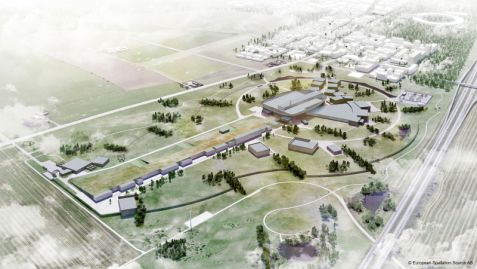MLZ is a cooperation between:
 > Technische Universität München
> Technische Universität München > Helmholtz-Zentrum Hereon
> Helmholtz-Zentrum Hereon
 > Forschungszentrum Jülich
> Forschungszentrum Jülich
MLZ is a member of:
 > LENS
> LENS > ERF-AISBL
> ERF-AISBL
MLZ on social media:

MLZ (eng)
Lichtenbergstr.1
85748 Garching
09.10.2014
Foundation Stone Ceremony Marks Scientific Importance of ESS
Today, several hundred members of the European scientific community gathered at the European Spallation Source (ESS) construction site in Lund, Sweden, for the ESS Foundation Stone Ceremony. The event was held to ‘lay the foundation’ both for the new facility, which has recently begun construction, and for a new generation of science in Europe.
ESS is a consortium of European nations cooperating in the design and construction of one of Europe’s largest active infrastructure projects. Today’s event follows the ESS groundbreaking held in early September, when the host countries, Sweden and Denmark, recognised their successful establishment of the pan-European political and economic partnership for ESS.
“ESS is a large-scale Research Infrastructure, which has evolved to meet the scientific demand for facilities that are beyond the capability of individual nations or institutions in scope and complexity”, says Jim Yeck, ESS Director General. “Scientists and engineers from all over the world are involved in the construction of ESS”.
Following on two decades of increasingly sophisticated technical design work, scientists, engineers, project managers and builders have now embarked on the construction of the most powerful neutron source in the world. ESS will provide the tools for analysis that will enable the next important discoveries in nanotechnology, life sciences, pharmaceuticals, materials engineering and experimental physics. It is understood that ESS, both through the research that will be performed there and the establishment of the facility itself, will serve as an economic driver for all of Europe.
First neutrons are expected by 2019 and the first experiments are scheduled to begin in 2023. The cost of ESS is calculated to € 1,843 billion.
“It has taken more than 20 years to reach the point where we are today”, says Yeck, ESS General Director. “The construction has started thanks to the dedication of countless people who have contributed with their scientific drive, technological inventiveness and administrative determination. We are very proud to be where we are, but also very well aware of the responsibility we carry”.
The Technical University of Munich will bring their great tradition in the use of neutrons for science, industry and medicine to the development and construction of two innovative instruments. It will do this together with academic partners from France and Switzerland in the spirit of this great European idea. Under discussion are ODIN, a tool for radiography and tomography, which can make visible combustion process in engines running for the first time probably completely non-destructive and thus contributes to the development of more efficient engines. Another instrument should be C-SPEC, a time-of-flight spectrometer with cold neutrons, that is specialized – due to the pulsed high intensity – to the measurement of atomic motions in molecules. This instrument will allow to dissolve the internal dynamics of proteins in the nanosecond range and so, for example, to study the uptake of oxygen in the hemoglobin or the penetration of drugs through the cell wall. Prof. Dr. Winfried Petry (TUM) complements from the perspective of the FRM II: “In the spirit of Heinz Maier-Leibnitz, the nestor of neutron research in Europe and longtime university teacher at TUM we look forward to the adventure ESS. Adventure, because the high intensity pulsed neutron beam at the ESS let us expect completely new insights into nature.”
For further information, please contact:
Allen Weeks, Head of Communications and External Relations, allen.weeks@esss.se
+46 46 888 31 52.
For facts, images and illustrations, please visit www.europeanspallationsource.se.
MLZ is a cooperation between:
 > Technische Universität München
> Technische Universität München > Helmholtz-Zentrum Hereon
> Helmholtz-Zentrum Hereon
 > Forschungszentrum Jülich
> Forschungszentrum Jülich
MLZ is a member of:
 > LENS
> LENS > ERF-AISBL
> ERF-AISBL
MLZ on social media:




